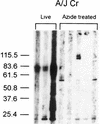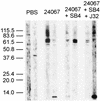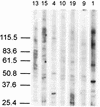Antibody response to Cryptococcus neoformans proteins in rodents and humans
- PMID: 10225877
- PMCID: PMC115960
- DOI: 10.1128/IAI.67.5.2218-2224.1999
Antibody response to Cryptococcus neoformans proteins in rodents and humans
Abstract
The prevalence and specificity of serum antibodies to Cryptococcus neoformans proteins was studied in mice and rats with experimental infection, in individuals with or without a history of potential laboratory exposure to C. neoformans, human immunodeficiency virus (HIV)-positive individuals who developed cryptococcosis, in matched samples from HIV-positive individuals who did not develop cryptococcosis, and in HIV-negative individuals. Rodents had little or no serum antibody reactive with C. neoformans proteins prior to infection. The intensity and specificity of the rodent antibody response were dependent on the species, the mouse strain, and the viability of the inoculum. All humans had serum antibodies reactive with C. neoformans proteins regardless of the potential exposure, the HIV infection status, or the subsequent development of cryptococcosis. Our results indicate (i) a high prevalence of antibodies reactive with C. neoformans proteins in the sera of rodents after cryptococcal infection and in humans with or without HIV infection; (ii) qualitative and quantitative differences in the antibody profiles of HIV-positive individuals; and (iii) similarities and differences between humans, mice, and rats with respect to the specificity of the antibodies reactive with C. neoformans proteins. The results are consistent with the view that C. neoformans infections are common in human populations, and the results have implications for the development of vaccination strategies against cryptococcosis.
Figures




References
-
- Atkinson A J, Bennett J E. Experience with a new skin test antigen prepared from Cryptococcus neoformans. Am Rev Resp Dis. 1968;97:637–643. - PubMed
-
- Baker R D. The primary pulmonary lymph node complex of cryptococcosis. Am J Clin Pathol. 1976;65:83–92. - PubMed
-
- Bindschadler D D, Bennett J E. Serology of human cryptococcosis. Ann Intern Med. 1968;69:45–52. - PubMed
-
- Casadevall A, Cassone A, Bistoni F, Cutler J E, Magliani W, Murphy J W, Polonelli L, Romani L. Antibody and/or cell-mediated immunity, protective mechanisms in fungal disease: an ongoing dilemma or an unnecessary dispute? Med Mycol. 1998;36:95–105. - PubMed
Publication types
MeSH terms
Substances
Grants and funding
LinkOut - more resources
Full Text Sources

